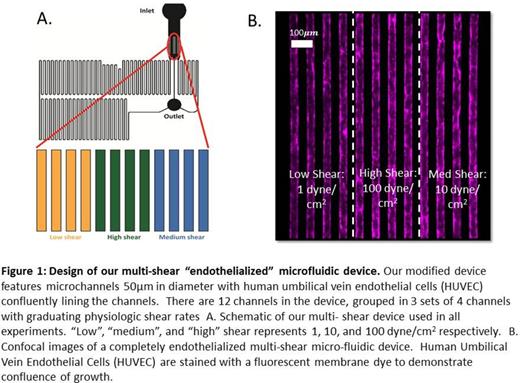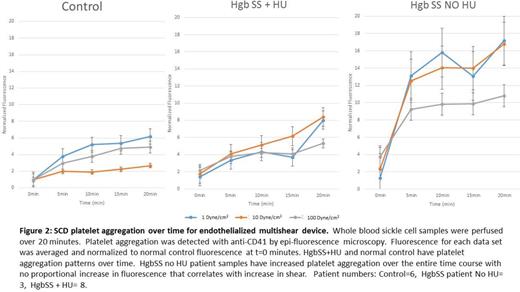Abstract
Introduction:
Sickle Cell Disease (SCD) is an inherited monogenic hemoglobin disorder characterized by decreased red blood cells (RBCs) deformability. While RBCs are directly affected by this mutation, the interaction of these cells in the milieu of other components including white blood cells (WBCs), platelets, and soluble factors in whole blood are also thought to contribute to microvascular occlusion in SCD pathophysiology. Several studies have suggested that platelet activation is increased in SCD, but how platelets affect microvascular occlusion is unknown.
As cellular interactions are affected by different flow conditions, we leveraged our previous "endothelialized" microfluidic technology (Tsai et al, JCI, 2012) to develop a novel multi-shear microfludic device to investigate blood cell-endothelial cell interactions in 3 different shear rates spanning 3 orders of magnitude ranging from venous to arteriolar shear conditions found in vivo (Figure 1). As platelets are shear-sensitive, this device is conducive to studying platelet interactions in SCD.
In addition, we utilized our multi-shear endothelialized microfluidic device for drug discovery, elucidating the mechanism of action of Purified Poloxamer 188 (MST-188). MST-188 is a non-ionic, block copolymer surfactant that has been studied in nearly 400 patients with SCD and is currently being investigated in EPIC (Evaluation of Purified Poloxamer 188 In Crisis), a Phase III trial. MST-188 is composed of a single chain of hydrophobic polyoxypropylene flanked by two hydrophilic polyoxyethylene chains. It is hypothesized to improve microvascular blood flow by reducing viscosity, particularly under low shear conditions, and reducing adhesive frictional forces (Ballas et al 2004). We utilized our endothlelialized multi-shear microfluidic technology to observe cellular interactions in SCD patient samples treated with MST-188.
Methods:
Whole blood samples were collected from Pediatric patients with HgbSS SCD, including patients on hydroxyurea (HU) via venipuncture in citrate collecting tubes. Samples were recalcified and perfused through a confluently endothelialized multi-shear microfluidic device for 20 minutes. Time-lapse epiflourescence videomicroscopy was obtained to observe cellular interactions under different physiologic flow conditions.
Results:
Platelet Aggregation in SCD: Using whole blood samples from SCD patients, we observed that platelet aggregation is markedly increased in Hgb SS patients not on HU compared to samples from control and Hgb SS patients on HU (Figure 2). This effect occurs for all shear rates.
Attenuation of phosphotadylserine (PS) exposure by MST-188: When a cell undergoes apoptosis, PS "flips" from the intra- to extracellular surface acting as a signal for macrophage engulfment. In order to identify target cell populations a thin smear whole blood from a patient with HgbSS not on HU (Figure 3A). Samples were fluorescently tagged with anti-CD41 to identify platelets and Annexin V to identify the presence of PS (Figure 3B). Patients with HgbSS not on HU have relatively increased fluorescence that is attenuated with treatment with MST-188 (Figure 3C).
Conclusion and Future Directions:
We have successfully demonstrated a correlation with increased platelet aggregation in endothelialized microfluidic channels in patients with SCD compared to normal controls. The platelets of SCD patients have an increased propensity to aggregate in an abnormal non-shear dependent fashion which correlated directly with fluorescence. This phenomenon appears to be attenuated in patients with SCD on HU in all shear rates. We have also demonstrated that MST-188 attenuates PS exposure mostly found on irreversibly sickled cells.
We believe this data and investigational platform to be a good springboard to unravel the utility of targeting platelet specific therapies to augment the course of VOC. This platform can also be used to continue to determine mechanism of action of MST-188 in disease processes, including SCD where inflammation and increased cellular turnover plays a critical role in pathology. Experiments investigating platelet activation markers, co-localization of other cell types including ISCs, reticulocytes and WBC subpopulations with platelet aggregates, as well as characterizing our microfluidic model under de-oxygenated conditions are currently ongoing.
No relevant conflicts of interest to declare.
Author notes
Asterisk with author names denotes non-ASH members.




This feature is available to Subscribers Only
Sign In or Create an Account Close Modal